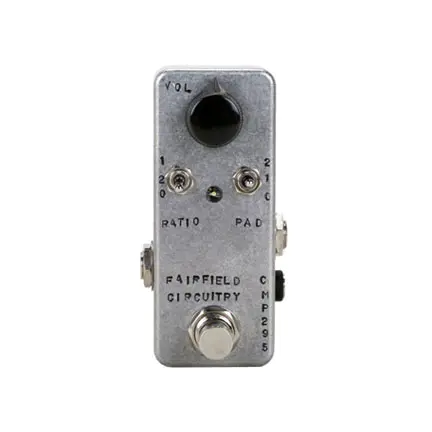Boutique Pedal Manufacturers have started popping up in extreme number as of late. That was made clear at this year’s NAMM show. The internet has provided a place for these small operations to sell their wares and to get their name out there at a rapid pace. If people love what you do they are going to talk about it and if what you’re offering is truly amazing you will sell units. That’s the hope at least. One of my favorite boutique manufacturers yields from Hull, Quebec and goes by the name of Fairfield Circuitry. I loved their Four Eyes Fuzz and Randy’s Revenge Ring Mod and today I’m taking look at their Accountant Compressor. It looks like they fit quite the feature set into a really small enclosure.
I feel like pretty much any guitar player could benefit from just the right amount and appropriate type of compression to complete their tone. Compression reduces the volume of loud sounds or amplifies quiet sounds by narrowing or “compressing” an audio signal’s dynamic range. So there are times when this phenomenon can truly accentuate the sound, style, or effect you are trying to deliver.
The Accountant is a JFET Feedback solid-state style compressor. It has controls for Ratio, Pad or input signal attenuator, and Volume or make-up gain. By setting these different controls you can drastically affect the dynamics of your signal. The Threshold is preset so there is nothing to adjust there, however, you can affect how hard the incoming signal hits the compressor by using the Pad. A setting of “2” lets full signal level through and provides no attenuation. A setting of “1” attenuates the signal by 8 dB. The “0” setting attenuates the input signal by a whopping 16 dB. By attenuating and choosing a Ratio (“1” is 6:1, “2” is 12:1, and “0” is 3:1) you are essentially shaping the dynamics of your signal. The Ratio says that it takes an increase of whatever the first digit is in dB above the preset threshold level to get a net increase of 1 dB at the output. The change does not happen instantly. The Attack and Release controls determine how fast and for how long the compression remains active and those controls on The Accountant are preset at 5 ms for Attack and 500 ms for Release. After you’ve shaped the dynamic range of your signal you may need to increase the overall volume to make up the gain lost. The overall result should sound denser and less dynamic but in a pleasing way. If it starts to sound unnatural with lots of audible artifacts you may be compressing too much, apply the pad or adjust the ratio to either 1 or 0 or both to remedy this.
How does The Accountant sound? It sounds a lot bigger than its size that’s for sure. I tried it on a multitude of sources including vocals, synth, bass, guitar, and drums. First off, it is extremely easy to dial in. As you flip through the various pad and ratio settings it starts to become really obvious which setting is best for the particular application. I like that the Attack and Release settings are preset. It makes it easier to quickly dial in a setting that works. With the flick of a few switches, you can go from subtle to aggressive compression. The fidelity of this compressor is top notch. At more conservative settings it doesn’t really color your sound, it just adds a little gusto. At more extreme settings, it does impart some pleasing distortion and color. I found this to be very desirable when aiming to squash the signal. It has a really sweet sound no matter what. It has to be heard to be fully understood. If you want a diverse yet simple compressor with a small footprint look no further. You’ve found The Accountant. – Gus Green
We added the Fairfield Circuitry The Accountant to our article about the best mini-compressor pedals.























